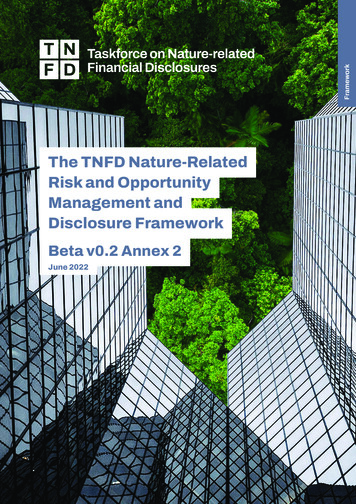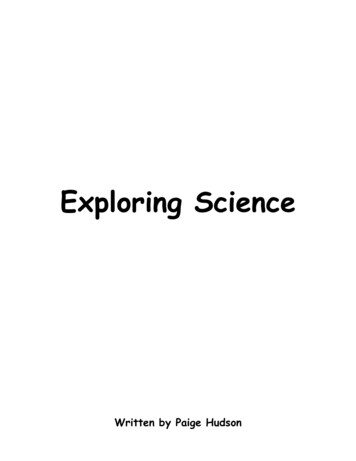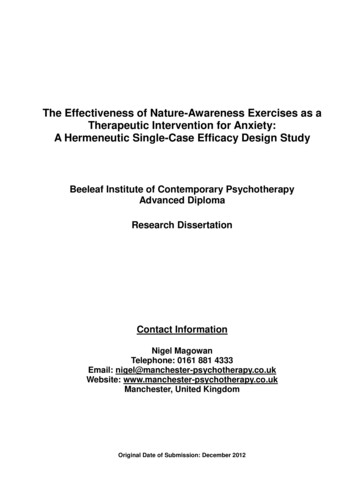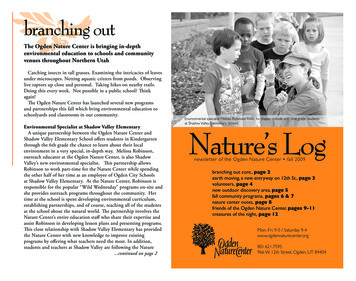
Transcription
FrameworkThe TNFD Nature-RelatedRisk and OpportunityManagement andDisclosure FrameworkBeta v0.2 Annex 2June 2022
Illustrative Dependency& Impact MetricsGuidance onReference ConditionAnnex 2:Illustrative Dependency and ImpactAssessment Metrics for Pilot TestingTo support the Taskforce’s efforts to identify and refine a set of Assessment and Disclosure Metricsfor the September 2023 recommendations, the Taskforce is releasing in draft form a set of illustrativemetrics for market participants to test, listed below. This set of illustrative metrics for pilot testing isbased on a landscape assessment completed by the TNFD, which identified over 3,000 metrics in usetoday across a wide range of frameworks and disclosure standards, including but not limited to CDSB,CDP, GRI, Accountability Framework (Afi), International Capital Market Association (ICMA) and SASB.To inform the TNFD framework design and development process to September 2023, the Taskforce isparticularly interested in feedback on the following key issues and questions:1. Are these illustrative metrics practical to use, given current organisational capabilities and access todata sources?2. Does the use of these illustrative metrics adequately support completion of the Dependencyand Impact analysis components in the E Phase of the LEAP approach (E3 and E4), or equivalentactivities the organisation may undertake using its own proprietary approach? If not, what metricsdo you believe are missing that have broad relevance across sectors, or in your specific sector,and could usefully be considered by the Taskforce for inclusion in the final recommended set ofAssessment Metrics for Dependency and Impact Analysis?3. Did the use of these metrics, in conjunction with the TNFD’s LEAP approach and related guidance,help to inform better organisational awareness of, and decision making around, nature-relateddependencies and impacts, and specific corporate decisions around strategy, governance, riskmanagement and capital allocation?4. For financial institutions, did the use of these metrics, in conjunction with the TNFD’s LEAP-FIapproach, help to inform better decision making around exposures in, and risk managementapproaches for, investment and credit portfolios?For further detailed step-by-step guidance on dependency and impact analysis (Components E3 & E4in LEAP) the TNFD has prepared a separate guidance note on with the Capitals Coalition, which can befound here.23
E2Identify dependenciesand impactsImpactsDependencyanalysisE3E4Illustrative Dependency& Impact MetricsIllustrative Dependency& Impact MetricsE1Identify relevantenvironmental assets &ecosystem servicesImpactanalysisDependenciesState of ionriskConditionImpact driversEcosystem servicesProvisioning servicesLand/water/sea museMarineecosystemuseResourceuseWater ionsPollutionInvasivespecies andotherNon-GHG turbancesSoil pollutionPhysical statecharacteristics:physical descriptorsof the abioticcomponents ofthe ecosystemCompositional statecharacteristics:Structural statecharacteristics:the composition/diversity aggregate propertiesof ecological communities (e.g., mass, density)at a given time/locationof the wholeecosystem or(e.g. species abundance,(e.g., soil structure,its main bioticspecies richness). Bestwater availability);componentspractice ecosystemChemical statemetrics should consider(e.g., total biomass,characteristics:changes in thecanopy coverage);chemical composition composition of species,of abiotic ecosystem regardless of their rarityelements (e.g. water or threat status or value,quality, soil nutrientcompared to an intactlevels, air pollutantreference state;concentrations);Functional statecharacteristics:summarise thebiological, chemicaland physicalinteractionsbetween ecosystemcompartments(e.g. primaryproductivity,disturbancefrequency); andLandscapeand seascapecharacteristics:describe thespatial scales ofecosystems(e.g. er supplyGenetic esRegulating & maintenance servicesPollinationSoil andsedimentretentionWater flowregulationSolid r filtrationSoil qualityregulationNurserypopulationand habitatmaintenanceLocal (microand meso)climateregulationBiologicalcontrolGlobal climateregulationRainfall her regulatingand maintenanceservicesCultural servicesSoil esEducation,scientific& istic andsymbolicservices5
Impact driver metricsThe following table contains an illustrative set of metrics for each impact driver (focusing on direct operations only).XLand/water/sea use changeTerrestrial ecosystem use overlap with legally protected andinternationally recognised areasArea of land owned, leased and/or operated in that is withinor in close proximity to legally protected and internationallyrecognised areas (e.g. legally protected areas, UNESCO WorldHeritage sites, UNESCO Biosphere Reserves, Ramsar sites, KeyBiodiversity Areas)Km2 orequivalentCDP ForestsxxxxCDP Forests; WBA; SASBEcological ImpactsxxxxCDSB BiodiversityxxxxFramework referenceTerrestrial ecosystem useExtent of land used for business activityArea of natural terrestrial ecosystems owned, leased and/oroperated in by ecosystem type and business activityKm2 orequivalentTerrestrial ecosystem useTerrestrial ecosystem use overlap with legally protected andinternationally recognised areasPercentage of land owned, leased and/or operated withinlegally protected and internationally recognised areas (e.g.UNESCO World Heritage sites, UNESCO Biosphere Reserves,Ramsar sites, Key Biodiversity Areas)PercentageExtent of marine area convertedArea of marine area converted/degraded by ecosystem type(before and after) and business activityKm2 orequivalentCDSB BiodiversityxxxxKm2 orequivalentCDP Forests, WBA; SASBEcological ImpactsxxxxxxxxMarine ecosystem useSASB Ecological ImpactsxXMarine ecosystem useMarine ecosystem use overlap with legally protected andinternationally recognised areasArea of marine ecosystems owned, leased and/or operatedin that is within or in close proximity to legally protected andinternationally recognised areas (e.g. legally protected areas,UNESCO World Heritage sites, UNESCO Biosphere Reserves,Ramsar sites, Key Biodiversity Areas)XMarine ecosystem useExtent of marine area used for business activityArea of natural marine ecosystems owned, leased and/oroperated in by ecosystem type and business activityKm2 orequivalentCDSB BiodiversityMarine ecosystem use overlap with legally protected andinternationally recognised areasPercentage of marine area owned, leased, and/or operatedwithin legally protected or internationally recognised areas (e.g.UNESCO World Heritage sites, UNESCO Biosphere Reserves,Ramsar sites, Key Biodiversity Areas)PercentageSASB Ecological ImpactsKm2 orequivalentCDP Forests, WBA; SASBEcological ImpactsxxxxXMarine ecosystem usexXFreshwater ecosystemuseFreshwater ecosystem use overlap with legally protected andinternationally recognised areasArea of freshwater ecosystems owned, leased and/or operatedin within or in close proximity to legally protected andinternationally recognised areas (e.g. legally protected areas,UNESCO World Heritage sites, UNESCO Biosphere Reserves,Ramsar sites, Key Biodiversity Areas)XFreshwater ecosystemuseExtent of freshwater area convertedArea of freshwater area converted/degraded by ecosystem type(before and after) and business activityKm2 orequivalentCDSB BiodiversityxxxxXFreshwater ecosystemuseExtent of freshwater area used for business activityArea of natural freshwater ecosystems owned, leased and/oroperated in by ecosystem type and business activityKm2 orequivalentCDSB BiodiversityxxxxPercentageSASB Ecological ImpactsxxxxXFreshwater ecosystemuseFreshwater ecosystem use overlap with legally protected andinternationally recognised areasPercentage of freshwater area owned, leased and/or operatedin within legally protected or internationally recognisedareas (e.g. UNESCO World Heritage sites, UNESCO BiosphereReserves, Ramsar sites, Key Biodiversity Areas)XFreshwater ecosystemuseFreshwater area restoredArea of freshwater habitat restored split into ecosystem typesKm2 orequivalentWBAxxxxTerrestrial ecosystem useLand restoredArea of terrestrial habitat restored split into ecosystem typesKm2 orequivalentWBAxxxxFreshwater ecosystemuseMarine area restoredArea of marine habitat restored split into ecosystem typesKm2 orequivalentWBAxxxxXXAnnex 2AreaExtent of land convertedKm2 orequivalentSite/facilityMetricArea of land converted/degraded by ecosystem type (beforeand after) and business activityEntityAirOceanWaterXIndicatorUnit ofmeasureProductLand/water/sea use changeTerrestrial ecosystem useXXLand/water/sea use changeImpact driverTerrestrial ecosystem useX6Level ofmetricRealmLandAnnex 2Impact driverTable 15: Illustrative indicators and metrics for impact drivers7
Soil pollutantsPollutants released to soilXSoil pollutantsPollutants released to soilXSoil pollutantsPollutants released to soil within or in close proximity to legallyprotected or internationally recognised areasWater pollutantsVolume of water dischargedPollutionXXTonnesICMA HFIR – Transport, SFDRPAI, WBA-B8TonnesCDSB BiodiversityCountxxxxxxxxxxxxTonnesCDSB BiodiversityVolume of water discharged (total, freshwater, other)Cubic metreor equivalentCDSB Biodiversity; GRI 11.6.5 Oil& Gas /GRI 303-4; CDP WaterxxxxCubic metreor equivalentCDSB Biodiversity; GRI 11.6.5Oil & Gas /GRI 303-4; CDPxxxxxxxxxXXWater pollutantsVolume of water discharged to legally protected, internationallyrecognised or water-stressed areasVolume of water discharged (total, freshwater, other) to areasof water stress and legally protected and internationallyrecognised areas (e.g. legally protected areas, UNESCO WorldHeritage sites, UNESCO Biosphere Reserves, Ramsar sites, KeyBiodiversity Areas)XXWater pollutantsConcentration of water pollutantsConcentrations of key pollutants in the wastewater discharged(e.g. hydrocarbons or nitrogen)XXWater pollutantsVolume of water discharged to destinationsXXWater pollutantsWater-related detrimental incidentsXXWater pollutantsVolume of wastewater treated, reused, or avoidedXSolid wasteXVolume of water discharged (total, freshwater, other) todestinations (e.g. fresh surface water, brackish surface water,groundwater, seawater, third party destinations)Number of water-related detrimental impact incidentsexperienced by organisation by locationConcentration(e.g. mg/cubicmeter)Concentration(e.g. mg/cubicmeter)GRI 11.6.5 Oil & Gas /GRI 3034; CDSB WaterGRI 11.6.5 Oil & Gas /GRI 3034; CDP Water – W5 Facilitylevel water accountingxCountCDP WaterxxxVolume of wastewater treated, reused, or avoidedCubic metreor equivalentICMA Water – B – WastewaterTreatmentxxxHazardous waste generatedTotal amount of hazardous waste generated by typeTonnesSolid wasteNon-hazardous waste generatedTotal amount of non-hazardous waste generated by typeTonnesXSolid wasteWaste disposalTotal amount of hazardous and non-hazardous waste bytype disposed of by type of disposal (incineration with energyrecovery, incineration without energy recovery, landfilling, other)TonnesXSolid wasteWaste minimised, reused or recycledTotal amount of waste by type minimised, reused or recycledXSolid wasteWaste minimised, reused or recycledCDSB Biodiversity; GRI 303Waste; ESRS-5CDSB Biodiversity; GRI 303Waste; ESRS-5xxxxCDSB Biodiversity; ESRS-5xxTonnesICMA HFIR – BuildingsxxxxShare of total waste minimised, reused or recycledPercentageICMA HFIR – BuildingsxxxxXXWater useTotal water consumptionVolume of water consumption (total, freshwater, other)Cubic metreor equivalentCDSB Biodiversity, GRI; CDPWaterxxxxXXWater useWater consumption by sourceVolume of water consumption (total, freshwater, other) by otherCubic metre(e.g. surface water, groundwater, seawater, produced water,or equivalentthird-party water)CDSB Biodiversity, GRI; CDPWaterxxxxXXWater useWater consumption from water stressed areasVolume of water consumption (total, freshwater, other) fromareas of water stressCubic metreor equivalentCDSB Biodiversity, GRI; CDPWaterxxxxXXWater useTotal water withdrawalVolume of water withdrawals from all areas (total, freshwater, other)Cubic metreor equivalentCDSB Biodiversity, GRI; CDPWaterxxxxAnnex 2Framework referenceAreaXVolume of non-GHG pollutants released to air by type (particulatematter (PM), sulphur oxides (SOx), nitrogen oxides (NOx), carbonmonoxide (CO), persistent organic pollutants (POP), volatileorganic compounds (VOC), hazardous air pollutants (HAP))Total pollutants released to soil split into types (e.g. pesticides)Number of soil-related detrimental impact incidentsexperienced by organisation by locationTotal pollutants released to soil in or in close proximity tolegally protected and internationally recognised areas (e.g.legally protected areas, UNESCO World Heritage sites, UNESCOBiosphere Reserves, Ramsar sites, Key Biodiversity Areas)Unit ofmeasureSite/facilityVolume of non-GHG pollutants released to airMetricEntityIndicatorProductImpact driverNon-GHG air pollutantsXPollutionPollutionResource useAirOceanWaterLandImpact driverRealmPollutionAnnex 28Level ofmetric9
Water withdrawal from water stressed areasXXWater useWater reused or recycledVolume of water (total, freshwater, other) reused or recycledXXWater useWater reused or recycledXXWater useWater loss mitigationShare of water reused or recycledVolume of water loss mitigated (e.g. evaporation mitigation,leakage mitigation)XXWater useProduced waterXOther resource useUse of natural resources sourced from landXOther resource useUse of natural resources sourced from landXOther resource useUse of natural resources sourced from marine areasXOther resource useUse of natural resources sourced from marine areasXOther resource useUse of natural resources sourced from marine areasXOther resource useUse of natural resources sourced from freshwater areasCDSB Biodiversity, GRI; CDPWaterxxxxCubic metreor equivalentCubic metreor equivalentPercentageCubic metreor equivalentCubic metreor equivalentCDSB Biodiversity, GRI; CDPWaterxxxxSFDR PAI; CDP WaterxxxxSFDR PAI; CDP WaterxxxxxxxxxxTonnesCDPxxTonnesESRS-3, CDSB BiodiversityxxTonnesCDPxxTonnesESRS-3, CDSB BiodiversityxxTonnesCDPxxTonnesESRS-3, CDSB BiodiversityxxTonnesCDPxxPercentageCDPxxCountCDSB BiodiversityxxCountCDSB BiodiversityxxTonnesESRS-3 Requirement 13; WBA-15 xxSASB Air QualityxXXXOther resource useUse of natural resources sourced from priority areasXXXOther resource useUse of natural resources sourced from priority areasXXXOther resource useUse of wild speciesXXXOther resource useUse of wild speciesXXXPlastic productionExtent of area that the organisation controls and/or managesthat is used for the production of natural commodities sourcedfrom land, split into typesQuantity of high-risk commodities sourced from land split intotypes (such as leather, soil, palm oil, crops, timber)Extent of area that the organisation controls and/or managesthat is used for the production of natural commodities sourcedfrom marine areas, split into typesQuantity of high-risk commodities sourced from marine areassplit into types (such as gravel, oil, seafood, energy)Extent of area that the organisation controls and/or managesthat is used for the production of natural commodities sourcedfrom freshwater areas, split into typesQuantity of high-risk commodities sourced from freshwaterareas split into typesQuantity of natural commodities sourced from legally protected,internationally recognised areas (e.g. legally protected areas,UNESCO World Heritage sites, UNESCO Biosphere Reserves,Ramsar sites, Key Biodiversity Areas) split into typesShare (i.e. proportion) of natural commodities sourced fromlegally protected, internationally recognised areas (e.g. legallyprotected areas, UNESCO World Heritage sites, UNESCOBiosphere Reserves, Ramsar sites, Key Biodiversity Areas) orother priority areas, split into typesQuantity of wild species extracted from natural habitats forcommercial purposes, split into species types and realmsShare of wild species extracted from legally protected andinternationally recognised areas (e.g. legally protected areas,UNESCO World Heritage sites, UNESCO Biosphere Reserves,Ramsar sites, Key Biodiversity Areas)Volume of plastic producedScope 1, 2 and 3 emissionsRefer to TCFDLevel of invasive species in areaPresence/absence of invasive species in areaQualitativeResource useResource useVolume of water producedCubic metreor equivalentUnit ofmeasureXXXOther resource useGreenhouse gasemissionsBiological alterationsXXXBiological alterationsLevel of invasive species in areaAbsolute number of invasive speciesCountXXXDisturbancesLevel of noise pollutionDecibels of noise above normal levelDecibelsXFramework referencexAnnex 2Water useVolume of water withdrawals (total, freshwater, other) bysource (e.g. surface water, groundwater, seawater, producedwater, third-party water)Volume of water withdrawal (total, freshwater, other) fromareas of water r withdrawal by sourceImpact driverProductOceanWater useAirWaterXLandImpact driverXResource useAnnex 210Level ofmetricRealmxxxICMA Biodiversity – A –Protected areas and OECMxxCDSB Biodiversityx11
CompositionalstateEcologicalMeasures multiple Direct measurecommunity species (rather Coral reef surveyscomposition than the numberof a individualswithin a singlespecies) within anecosystem, giving aproxy of conditionEFRAGLandscape andseascapesPotentiallydisappearedfractionof species(PDF)The AlignProjectAnnex 2Example cross-sector indicators for ecosystems and species are given below. Some use directmeasurement techniques, while others use impact driver data as proxies. Recognising the variabilityin the availability of data, examples of indicators are provided, together with existing measurementtools and techniques. The indicators set out below are illustrative only. In later beta releases, theTNFD will develop a more comprehensive guidance list with suggested proxies and data sources withan indication of strengths, weaknesses and limitations.Table 16: Example indicators and measurement tools and techniques – state of natureCharacteristics ExampleindicatorDescriptionExample means ofmeasurementSourceWhat to measureEcosystem extentN/AHabitat/landcover (e.g.forest, coralreef)Measuresthe extent ofa particularecosystem typewithout factoring inthe condition of theecosystemDirect measurement Habitat surveysEFRAG, TheAlign ProjectSecondary data Change in extent of tree coverover timeHansen etal1Measures the(average) changein populationsize of nativespecies in an areafrom a referenceintact state, thusproviding a proxyof ecosystemcondition.Direct measurement Species counts, eDNAThe AlignProjectSecondary/modelled data: Biodiversity footprinting,e.g. Global BiodiversityScore, Biodiversity Footprint,Financials CorporateBiodiversity FootprintEU B@BPlatform3Estimated state, e.g. based onland use Biodiversity Impact MetricUNEP-WCMCFunctional stateProxies Certification status wherecertification scheme addressesavoidance of habitat lossWhat to measureEcosystem conditionCompositionalstateSpeciesabundance(e.g. meanspeciesabundanceor MSA)Finance forBiodiversityFoundation4EFRAGUNEP-WCMCExisting analysis on state ofecosystems: 2 Hotspots of natural capitaldepletion Critical habitat mapFunctional stateMeasures‘intactness,fragmentation andconnectivity’ – theaverage changein local speciesrichness in an areafrom a referenceintact state.Secondary/modelled Terrestrial BiodiversityIntactness Index5Net primary Measures theModelledproductivity rate that energy is Vegetation index6stored by plantsand made availableto other speciesin the ecosystem,thus measuringthe productivity bymeasuring the coreprocess that occursfor ecosystems tofunction.KeystonespeciesMeasures changes Primary data based on surveys Biodiversity Indicator andto the populationReporting System (BIRS)of scientificallyidentified speciesof the assessmentarea to indicatechanges toecosystem function,i.e. those thathave an impacton an ecosystemdisproportionate totheir abundance.The AlignProjectAnnex 2Example state of nature RAGThe AlignProjectEFRAG5 Newbold, T., Hudson, L. N., Arnell, A. P., Contu, S., et al (2016) Has land pushed terrestrial biodiversity beyond the planetary1 Hansen, M. C., P. V. Potapov, R. Moore, M. Hancher, S. A. Turubanova, A. Tyukavina, D. Thau, S. V. Stehman, S. J. Goetz, T. R.boundary? A global assessment. Science 353 (6296), pp 288-291Loveland, A. Kommareddy, A. Egorov, L. Chini, C. O. Justice, and J. R. G. Townshend. 2013. “High-Resolution Global Maps of 21st-Helen Phillips; Adriana De Palma; Ricardo E Gonzalez; Sara Contu et al. (2021). Dataset: The Biodiversity Intactness Index – country,Century Forest Cover Change.” Science 342 (15 November): 850-53. Data available on-line from:region and global-level summaries for the year 1970 to 2050 under various scenarios. Natural History Museum Data Portal ce-2013-global-forest2 UNEP-WCMC (2021) Mapping global hotspots of natural capital depletion: Using ENCORE to identify natural capital risks andopportunities and focus investor engagement, Cambridge, UK, UNEP-WCMC (2017) Global Critical Habitat screening layernhm.ac.uk). https://doi.org/10.5519/he1eqmg16 https://lpdaac.usgs.gov/products/mod13a2v061/7 Cambridge Institute for Sustainability Leadership (CISL). Healthy ecosystem metric framework: biodiversity impact.(Version 1.0). Cambridge (UK): UN Environment World Conservation Monitoring Centre. DOI:https://doi.org/10.34892/nc6d-0z733 EU Business @ Biodiversity Platform (2019) Assessment of biodiversity measurement approaches for businesses and12financial institutions.4 Finance for Biodiversity Pledge (2022) Guide on biodiversity measurement approaches.13
What to measureSpecies population sizeN/ANumber ofindividualsof priorityspeciesNumber ofbreedingpairs ofpriorityspeciesIndicator measureschanges inthe number ofindividuals ofpriority species in aspecific areaDirect measurementMeasures the localpopulation sizeand may provideinformationon changes insuitability of anarea as a breedingground.Direct measurementEFRAGProxiesThe AlignProjectRSPBAnnex 2Annex 2N/A Species countsSecondary data Global Biodiversity InformationFacility Wild Bird Index8 Wild Bird IndexWhat to measureSpecies extinction riskN/AContribution Estimates howDirect measurementto extinction different activities Based on global or local datariskat a location maysets modelled and directdrive species Species Threat Abatement andextinctions globally.Restoration metric using IUCNRed List data9EFRAGChange inspecies areaof habitat(ha)EFRAGMeasures changePrimary data based on surveysin habitat size Species Threat Abatementas a proxy of aand Restoration metric usingchange to a species survey data10population sizeSecondary dataThe AlignProjectIUCNThe AlignProject IUCNSDG target15.1 Forest area as a percentage oftotal land areaSpecies richness and composition is assumed to be covered within the ecosystem condition andextent indicators, so it is not explicitly referenced within the species indicators above.The following table provides examples of biome-specific metrics, split into the six classes ofecosystem characteristics, defined by UN-SEEA.11 The Taskforce is evaluating the benefits of providingbiome-level guidance. The definition and taxonomy of biomes, following the UN-SEEA EcosystemAccounting, was outlined in the v0.1 beta framework. In the v0.2 beta release, TNFD providesexample assessment metrics for a small set of biomes across ocean, land and freshwater realms, toillustrate how state of nature metrics can be organized by biome. The Taskforce may develop a fullset of metrics of the state of nature by biome in subsequent releases.8 -index9 IBAT (2021) Species Threat Abatement and Restoration (STAR). A global metric supporting nature-positive action.10 Mair, L., Bennun, L.A., Brooks, T.M. et al. A metric for spatially explicit contributions to science-based species targets. Nat EcolEvol 5, 836–844 (2021). https://doi.org/10.1038/s41559-021-01432-01411 UN-SEEA (2021) System of Environmental-Economic Accounting-Ecosystem Accounting.15
Ecosystem typeRealmAnnex 2T2 Temperate-boreal forests Landand woodlands biomePhysical stateChemical stateCompositional stateStructural stateFunctional stateLandscape / seascapeVegetation water contentSoil organic carbon content;Air pollutant concentrationTree species richness;Lichen species richness;Bird species richnessSoil layer thickness; Treecover density; Forest ageclass distributionDensity of trees withhollows for nesting;Vegetation index; Waterstress indexForest area density;Landscape diversity; ForestconnectivityF1 Rivers and streamsFreshwaterRiver flow; Permanence ofwater flow; Sediment loadNitrogen concentration;Phosphorus concentrationMacro-invertebrate speciesrichnessArea of riverbanksvegetatedBiological oxygen demandShare of river flowcontrolled by barriers; Riversystem fragmentationM1 Marine shelfOceanWater clarity; (Micro)plasticconcentrationChlorophyll aCoral species richness; Fishspecies richnessReef bleachedness; Kelp/seagrass height, Density orcover; Live coral coverRatio between fishingmortality and fishing atmaximum sustainable yield;Biological oxygen demandSeagrass meadow coverImperviousnessNO2 concentrationBird species richnessShare of urban green space;Vegetation or treeT7.4 Urban and industrialecosystemsLandconcentration; Oxygenconcentration; pH (ordissolved CO2)Average distance ofresidents to urban greenspace; Landscape diversitycoverT4 Savannas and grasslandsLand% Bare groundSoil organic carbon content;Soil pHBird species richness;The presence/density oftrees/shrubsButterfly species richness;Proportion of non-nativespeciesAnnex 2Table 17: Example biome-specific metricsDry matter productivityConnectivity of trees;Grassland connectivityEcosystem service metricsExamples of ecosystem service metrics for select categories of ecosystem services considered to be broadly applicable across all sectors are contained below:16XXXAmount of water flow regulatedCapacity of reservoirs or alternative forms of storage (cubic metres) otherwiseneeded to provide same serviceCubic metre UN SEEA – EAor equivalentXXXAmount of water flow regulatedVolume of diverted water flow otherwise needed to provide same serviceCubic metre TNFDor equivalentXXXAmount of secure water supplyAltered level of number of people/businesses/acres with secure water supplyCountICMA CC A&RXXXAmount of water flow regulatedAltered level of livestock and or crops (e.g. reduced/avoided loss of livestock and/or crops)CountICMA CC A&RXXAltered risk level by incident size or damage costAltered risk level of incident (e.g., flood frequency)CountGRI, UNEP-WCMCand CREM (2011)Approach forreporting onecosystem services.XXAltered risk level by incident size or damage costNumber of people and buildings in a lower risk categoryCountUN SEEA – EAXXAltered risk level by incident size or damage costChange in flood damage costsDollar valueICMA CC A&Ror equivalentXXAltered risk level by incident size or damage costAltered level of land-loss from inundation and/or coastal erosion in km² (e.g.reduction of land-loss)Km2 orequivalentXAirOceanRiver floodmitigationservicesWaterEcosystemservice subcategoryWater flowregulationservices(baseline flowmaintenance;peak flowmitigation)RealmLandRegulating and maintenance servicesEcosystemserviceTable 18: Example ecosystem service metricsPotential indicatorPotential physical metric(s)PotentialunitFrameworkreference(s)ICMA CC A&R17
OceanAirXXXXTonnes of greenhouse gas (GHG) retainedTonnes of carbon and other greenhouse gases retained (sequestered and stored)within company operations or supply chainTonnes ofCO2EUN SEEA – EAXXXXAltered risk level by incident size or damage costAltered level in the number of wildfires and/or in the area damaged by wildfires inkm² (e.g. reduction in the number of wildfires)Km2 orequivalentICMA CC A&RXXXXTonnes of greenhouse gas (GHG) retainedAmount of carbon absorbed by vegetation (tons)Tonnes ofCO2ECDSB BiodiversityXXXXNumber of people affected due to climate-related hazardsNumber of people evacuated/injured/displaced/economically unproductive due toclimate-related hazards (e.g. reduced number of people injured)CountICMA CC A&R – E –Other sustainabilityindicatorsPotential indicatorPotential physical metric(s)PotentialunitFrameworkreference(s)Local (microand meso)climateregulationservicesXXNumber of people affected due to climate-related hazardsNumber of households with air temperature reduced by more than 5 C on hotdaysCountUN SEEA – EAAir filtrationservicesXXWeight or volume of pollutant filtered/remediatedTonnes of pollutants absorbed by type of pollutant (e.g., PM10; PM2.5)TonnesUN SEEA – EASoil andsedimentretentionservices(Soil erosioncontrolservices andlandslidemitigationservices)XTonnes of ecosystem asset retainedTonnes of soil retained; number of properties with reduced risk of landslideTonnesUN SEEA – EASolid wasteremediationXWeight or volume of pollutant filtered/remediatedTonnes of solid waste remediatedTonnesUN SEEA – EAWaterpurificationservicesXXTonnes of ecosystem asset retainedTonnes of pollutants remediated by type of pollutant (nutrients and otherpollutants)TonnesUN SEEA – EAXXArea of habitat providing servicesHectares of habitat providing water filtration; cubic meters /day of water filteredby vegetationHectare orequivalentCapital Coal
Red List data9 EFRAG The Align Project IUCN Change in species area of habitat (ha) Measures change in habitat size as a proxy of a change to a species population size Primary data based on surveys Species Threat Abatement and Restoration metric using survey data10 Secondary data Forest area as a percentage of total land area EFRAG The Align










